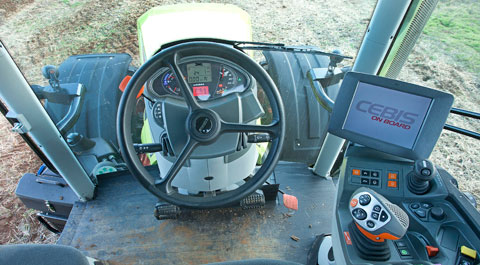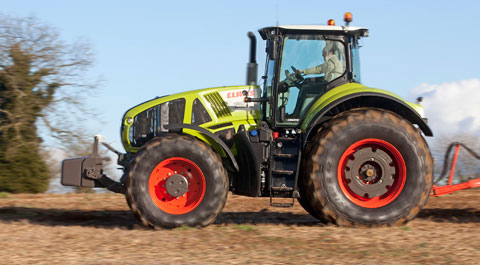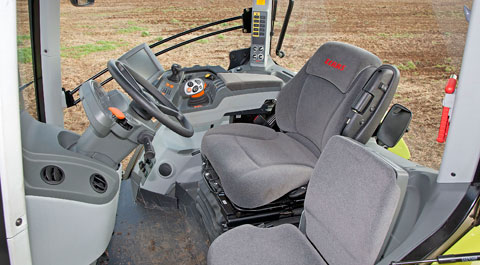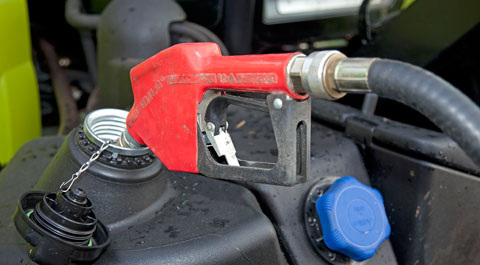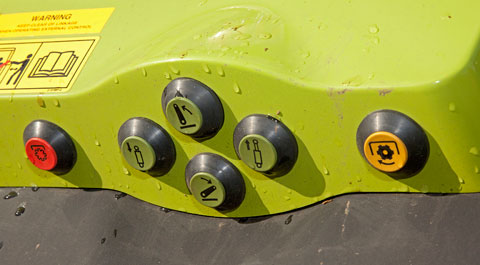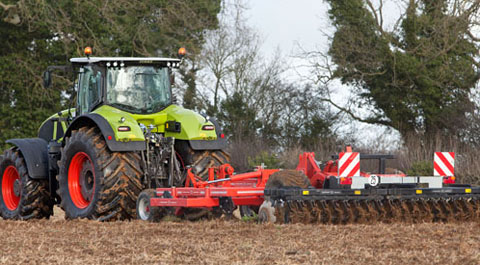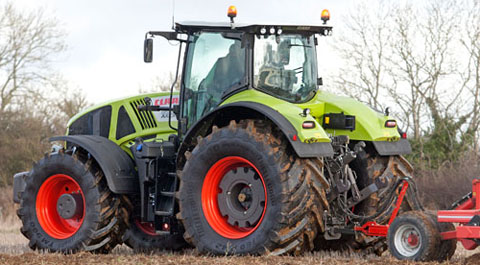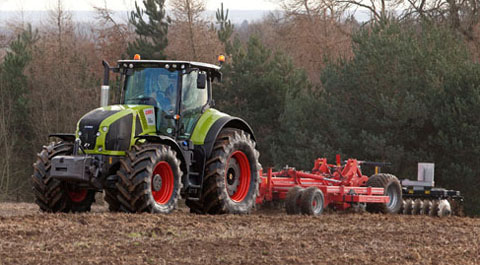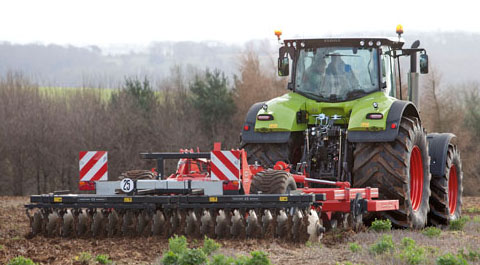Video: Claas Axion 950 – the biggest conventional tractor on the market
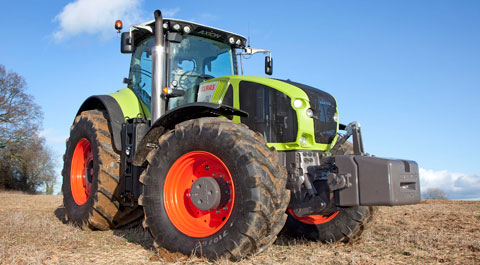
For a mighty machine, it can feel like a relative mouse when driving thanks to its well-managed bulk, mid-mounted cab and short bonnet.
It’s a simple tractor to jump on and drive, but there’s some strong competition in that high horsepower market, especially from tracked machines which are pretty much guaranteed to put their power to the ground.
With its new Axion 950 Claas has entered uncharted waters. Topping out at 410hp it is now the most powerful conventional tractor in the world. Oliver Mark and Nick Fone gave it the Power Farming shake-down to see how it performs
Watch the video and read the full report below.
It’s been seven long years since Claas has had a heavy draft tractor in its armoury. 2005 marked the point where stringent Tier 2 emissions rules meant the company had give up its flagship Atles tractors – pretty much unchanged in all but livery from the Renault range the German firm inherited in 2003.
To fill that void Claas has embarked on a Grand Designs-style build, with its sights set on making what is reckoned to be the most powerful conventional tractor on earth.
The pre-production model we got our mitts on is the biggest in the line-up. The four-model Axion 900 range kicks off with the 320hp 920 and climbs to the range topper we tested – the 950 – maxing out at a stump-pulling 410hp.
The new 900s fill the gap between the more slender Axion 800-series (180-260hp), and the maker’s monster Xerion range (330-525hp) – specialist machines with swivelling cabs, equal-sized wheels and all sorts of other clever kit.
These big Axions are far more traditional in their layout but the keener eyed will notice some familiar Xerion features adopted by the 900-series.
Gone is the big 7.2-litre Deutz engine and Funk powershift box of the old Atles (which is still built at the ex-Renault Le Mans plant for markets like Russia and the Ukraine where emissions are no issue) – the Axion 900 is a completely new machine.
The new models mark the introduction of Fiat Power Train engines to Claas tractors and for the first time the maker has used SCR (selective catalytic reduction) technology to meet Tier 4(a) emissions regulations. Putting those Italian stallions to the ground is a stepless ZF CVT box and some fairly chunky rubber, 900s in the case of our test machine.
Despite weighing in at 13t, the 950 appears deceptively small (until you come to negotiate the five vertical steps up into the cabin which certainly constitute a work-out for the calorie conscious).
Although its looks might be deceiving, the big Axion has a longer wheelbase than North American rivals like John Deere’s 8R and the Case Magnum, which Claas says improves traction. But the tractor’s mass is kept within the confines of it’s own footprint and overhangs are kept to a minimum which helps when it comes to manoeuvring.
Full UK prices and specs are due to be announced when the order books open in early summer, although it’s reckoned the 950 will come in at around an eye-watering £175,000 when full production starts towards the end of the year.
Aside from the tractor’s Shrek-green colour scheme, the cab is all-new. Most strikingly, its got a four-, rather than six-, post cab which is pretty roomy and sits just forward of the rear axle.
The advantages of choosing a four-poster are clear to see (excuse the pun), with excellent visibility all round. It’s spacious and, because everything SCR related is tucked neatly under the bonnet, the stack doesn’t hinder the view.
Being a long way back the hitch isn’t the easiest to see but there is a squint-inducing mirror bolted to the back window to help with the job.
Claas has also done away with waist-line struts across the front window, which means the fully-glazed front screen provides uninterrupted views of all the bits of the field you’ve missed.
Cab suspension remains a four-point mechanical system as used by Axion 800s, but is a completely redesigned unit beefed up and re-jigged to cope with the added weight and size of the new cab. Claas’ Z-Active mechanical/hydraulic cab suspension will be an option later on.
The dash has changed, too. Behind the wheel are displays indicating all the important engine management information and the whole lot is thinner which makes life easier when you’re clambering in and out.
There’s still a forward/reverse lever to the left of the dash which includes a “park” setting, but we found it was pretty easy to flick straight to park when shunting from reverse to head off up the field.
Forward and reverse are duplicated on the joystick though.
On the controls front a bulky new armrest dominates the right side of the cabin, and the centre-piece is a what looks like a button-clad microphone.
On closer inspection it’s the palm-sized handgrip/joystick taken from Xerion and Lexion machines, home to controls for all the major machine functions.
This gives finger-tip control over the direction of travel, speed ranges, cruise control, spool valves, the rear linkage, headland management and GPS steering.
Other key features can be found on the surrounding armrest, which might be more familiar to the pilot of a Harrier jump jet. These include more spool-valve controls (six as standard), which we found all too easily lock into float if you’re a bit over-zealous with the paddles.

One big plus-point is that you don’t have to know how the Cebis in-cab computer works to use the tractor. Some of the more important controls have been reserved a position on the rear pillar and are handled by more traditional dials.
It means minimal digital dexterity is required to operate most of the basic functions such as drop speed, the lift height limiter, wheel slip and draft control.
In spite of ample cab space, storage is lacking. You might feel slightly short changed in the toolbox department, too, with a pathetically plasticky box perched atop the fuel tank, suitable for little more than a Swiss Army knife.
Overall though, the cab is smart and modern enough, except for some switch gear which looks to have been plucked from an 1980s Renault – which it probably has.
Computer controls
The Cebis system is pretty logical and easy to use, even if you’re new to it. Its muted colour-scheme is easy enough to navigate with a thumbwheel to scroll through the various menus. It is apparently ISOBUS compatible too so that implements can be plumbed in directly without the need for a separate control box.
There’s a road-travel homepage or switch to the field page where you can see all manner of information, including 20 recordable fields and the three cruise control settings which set the tractor to run at a constant speed during field work.
Thwacking the cruise control button sets things in motion and the Axion lets you know it’s trying to get its big bulk up to speed with a reassuring “bing-bong” that sounds like it’s been borrowed from Sonic the Hedgehog or Super Mario Bros.
Claas says its multi-make engine policy means it can pick and choose engines at will. Tasked with selecting the best power-plant to provide the necessary performance for each job, Claas Power Systems (CPS) is a division set up to share drive information including engines, transmissions and axles across the company’s range of tractors, combines and foragers, as well as the most suitable form of emissions control.
Hence why the company employs both EGR and SCR technologies, with Deere’s engines in the 800-series, a Caterpillar block in the Xerions and Perkins four-pots in the little-uns.
The 900s are the first Claas tractors to benefit from Fiat engines. They use an 8.7-litre Cursor 9 power-plant. The six-cylinder, 24-valve, electronically managed block provides pumps out a maximum of 410hp (like other CVTs there is no additional power boost) and 1500 Nm torque is available down to below 1400 rpm.
As you’d expect, it’s Tier 4i compliant, using SCR exhaust treatment to convert NOx emissions to nitrogen, water and carbon dioxide, rather than the EGR (engine gas recirculation) option used by the Deere engines in the Axion 800 range.
It’s the company’s first AdBlue tractor, and the 60-litre tank is tucked inside the 700-litre diesel tank to protect it from any harsh temperatures.
Despite being Fiat engine, it has been Claas-ified. Delivered without a sump, the German firm bolts on its own purpose-designed, sculpted structural casting.
Not only does this mean the chunky front wheels can turn in tight against the body-work (at is lowest point the sump is no wider than a shoe-box) but also the webbed structure is sturdy enough to support a 6.8t front linkage without the need for chassis rails and added bracing.
This also allows the engine to be fitted low down allowing space for the SCR unit to be fitted on top of the engine rather than at the side to help visibility.</P
There’s also a new cooling system, which opens to give good access to the radiator and features a visctronic managed fan that works from the engine ECU, prompted to run only when it is needed and at the speed necessary.
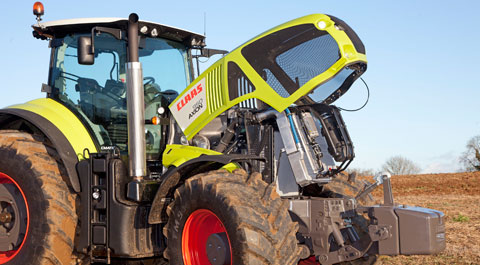
In the transmission department, Claas has turned to a four-range ZF Eccom CVT, providing stepless speeds up to 50kph.
The company says the emphasis remains on using more efficient mechanical drives, rather than hydrostatic, where possible, selected by multidisc clutches. The use of four automatically engaged ranges means the minimum degree of mechanical drive delivered to the rear axle is 60%.
The gearbox is controlled by the same Cmatic management system as used on 800-series Axions. There are three settings selected through the Cebis computer screen: auto, drivestick (for Fendt enthusiasts) and manual, which sees engine rpm controlled by the throttle and transmissions ratios handled by the sci-fi-style handgrip.
We found that for most jobs (bar pto work) the auto setting seems like the obvious choice. Up to three set speeds can be programmed in forward and reverse too, so set ranges for fieldwork, headlands and road work can be selected.
Backend</P<
Playing host to the ZF box, diff and pto gubbins, the transaxle comes from GIMA, the Claas/AGCO joint venture that produces transmissions for Massey Ferguson tractors as well as smaller Claas machines. There are two rear axle options, the 950 was fitted with the heavier duty version allowing for 2.15m tyres.

At the rear, there’s the option of Cat III or IV linkage. The linkage has a max lift of 11t and up to six electro-hydraulic spools can be fitted, with oil flows of up to 150-litres/min or 220-litres-min depending on the load-sensing pump you choose.
In addition two more spools can be fitted up front and front linkage carrying capacity is either 5t or 6.8t.
Sticking at the business end, the suspended front axle comes from Dana and either side the final drives incorporate five-disc wet brakes.
Despite having oodles of power, the Axion 950 really does need to be well ballasted to get all that power on the ground. We coupled the tractor up to a 4m Gregoire Besson Helios SP sub-soiler with eight cranked legs working to a depth of 14ins to 15ins and two gangs of discs at the rear.
Even with 600kg wheel weights on the back and over a tonne on the nose, going uphill the Axion has the tendency to squirm like a tabloid editor at The Leveson Inquiry. That said, we probably could have let the big tyres down to get a bit more bite.
Claas suggests there is no need for any additional front ballast though, because 44% of tractor weight is carried on the front axle. We would disagree.
Setting the tractor to run in auto is pretty simple and the throttle overrides the setting should you want to give it a bit more oompf.
Because it is set to run at for optimum fuel efficiency, the Fiat motor generally hangs around the 1300-1400rpm mark where peak torque occurs. It can be a little disconcerting at times as it often sounds like the engine in labouring, but rest assured it has plenty more to give.
We never really managed to get it to work really hard and there’s hardly ever the slightest bark.
Handling is remarkably nimble for a 410hp tractor, and it’s easy to forget you’re driving a machine that could quite easily pull a semi-detached house from it’s foundations. Given that, the engine little more than whispers and seems noisier inside than out.
The rivals
| Make and Model | Max Power | Price |
|---|---|---|
| John Deere 8360R | 396hp | £186,548 |
| Case IH Magnum EP | 374hp | £164,082 |
| Fendt 939 Vario | 390hp | £232,971 |
| Valtra S353 | 370hp | £176,247 |
| MF 8600 Dyna-VT | 370hp | £159,172 |
| New Holland T8.390 | 373hp | £162,283 |
| Challenger MT 845C | 473hp | £254,100 |
Likes and gripes
| Likes | Gripes |
|---|---|
| Spacious cab | Clumsy spools |
| Good visibility | Disappointing lighting (Xenon lighting is an option) |
| Easy to jump on and drive without having to use the in-cab computer | Computer short cut keys set-up complicated |
| Some settings accessible via dials |

